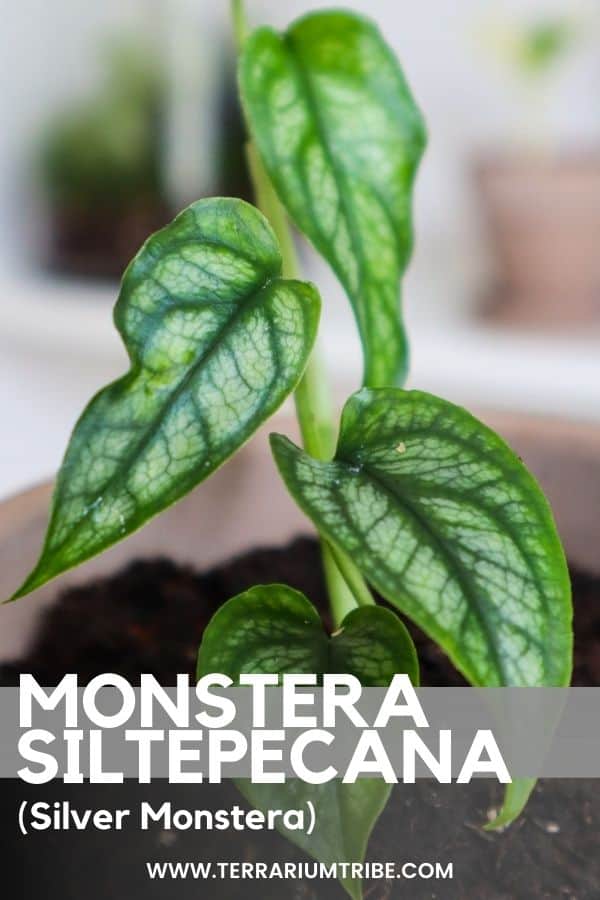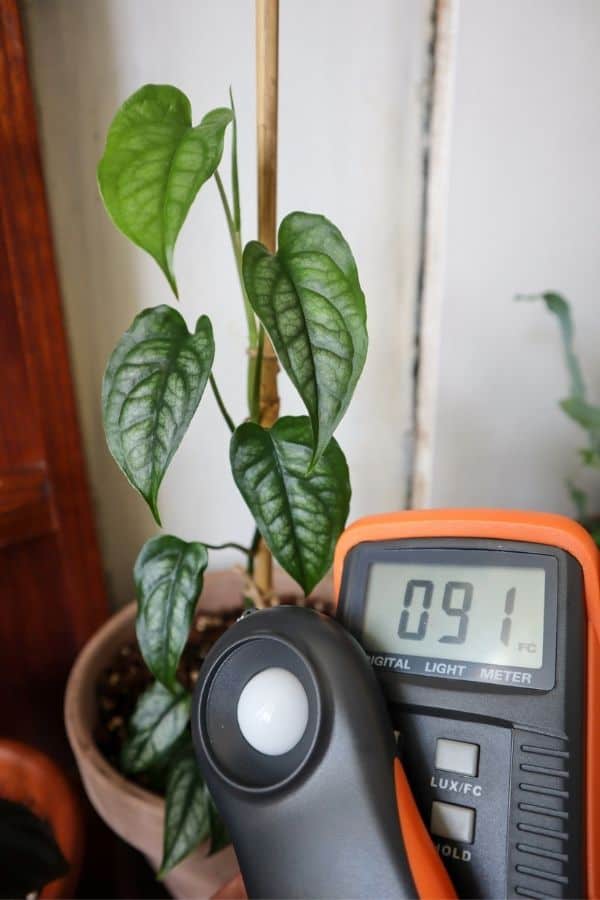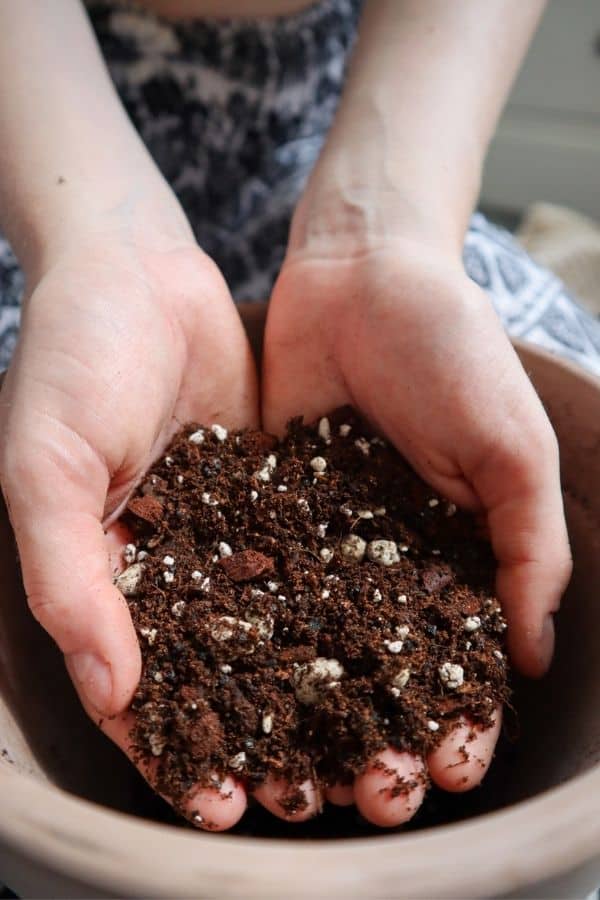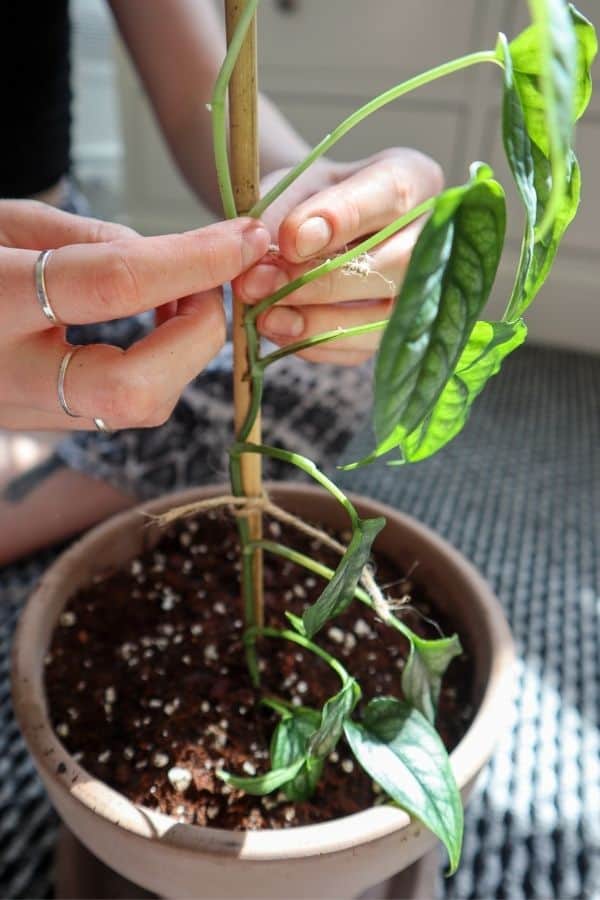Let’s face it, we all love a good Monstera.
And though this silver fox is pretty unique amongst its family, it’s an undeniable beauty.
Living quite the double life, the juvenile form of Monstera siltepecana actually looks completely different from its mature form.
Though it can form those characteristic Monstera fenestrations (the split leaves/holes) at full maturity, its juvenile form has full lance-shaped leaves with a gorgeous silvery hue and dark green veins.
It’s this versatility that makes the Silver Monstera a fantastic option for homes and terrariums alike.
Though not a difficult plant to keep, growing this species to maturity requires a special condition to be met. So, in this article, we’ll tell you exactly what you need to do to get the most out of your Monstera siltepecana!

What is the Monstera siltepecana? (& Why it’s Special)
Native to a variety of South and Central American regions, this species of Monstera is a much stronger viner than others in the family, and it really likes to climb.
In fact, to really nurture this plant, you’ll need to give it something to climb.
That’s because though the juvenile version of Monstera siltepecana is a happy terrestrial plant (usually found growing at the base of a tree) the mature version is more of an epiphyte.
In the wild, it needs to grow up that tree trunk to complete its growth cycle.
So, if you want this plant to develop into its full expression, you’ll need to support it with a large branch or moss pole. Alternatively, it’ll happily grow as an epiphytic creeper if it has nothing to climb.
(Just note, the size of the juvenile version is more suited to terrarium life, and only the largest terrariums can support a mature Monstera siltepecana).
Where to Find Monstera siltepecana for Sale
See the links below to purchase from reputable terrarium plant shops and marketplaces (may include affiliate links).
Monstera siltepecana Care & Growth
At a Glance
| Plant Type | Foliage, vine, large |
| Lighting | Bright, indirect light |
| Temperature | 55-90°F (12-32°C) |
| Watering | Regular, even moisture |
| Humidity | High humidity (60-90%) |
| Growth | 20-30 inches in juvenile form |
Lighting
As with many houseplants and other Monstera species, this plant can handle short periods of direct sunlight but will do best in a really bright spot out of direct sunlight.
Which makes sense when you consider that growing in the wild – terrestrially at the base of the trees or on them epiphytically – the Silver Monstera would predominantly receive filtered sunlight through the forest canopy, and periodic direct light as the Sun passes over the sky.
For those in the Northern Hemisphere, North and East-facing windows are your best bet.
Generally, Monstera siltepecana is pretty forgiving with its light requirements and can survive lower lighting conditions, but just don’t expect it to burst with growth.
Currently, my plant is in a shadier spot that’s averaging around 100 footcandles (as that’s the only place I can fit the tall stakes…), though it did most of its growing in a brighter area, getting around 200 footcandles.

Watering
Monstera siltepecana is a tropical species, so it definitely appreciates regular moisture, but then it’s also a partially epiphytic vine, so it won’t appreciate being sat in a soggy substrate.
Growing in the wild as an exposed vine, they’ll be thoroughly soaked from the rain and then dried from the Sun. So, matching your watering cycle to that in the home will yield good results.
As with many tropical plants, drainage holes in your pots are a must to divert excess water and prevent root rot.
In a terrarium, there’s a balance to be struck, but choosing the right substrate is half the battle (and drainage layers can help).
Depending on its level of maturity, it may need slightly different watering requirements, but they’re likely to thrive in most tropical terrarium setups (especially if they have lots of humidity).
Soil / Substrate Mix
Monstera siltepecana does best in a nutrient-rich substrate mix with excellent drainage.
As a potentially epiphytic grower, it’s likely going to do better in a chunkier, well-aerated mix too. Something that can really let those roots breathe.
Opting for a mix high in orchid bark and coco coir can really provide that much-needed water retention whilst still allowing for lots of aeration and drainage.

Humidity & Temperature
To be honest, Monstera siltepecana has very typical temperature and humidity requirements.
For most people, your average household conditions will be sufficient to keep them happy enough. Anything above 55°F (12°C) and 50% humidity is fine (and I honestly don’t know how you cope if your house is colder than that).
That being said, as a semi-epiphytic tropical species, you bet it’s going to appreciate every extra degree and humidity percentage it can get.
Humidifiers and pebble trays can help, no doubt, but a closed terrarium is the best way to really recreate its natural environment and help it thrive… but of course, I’m biased.
Growth
We’ve already touched on the particulars of this plant’s evolution, and so it’s really down to you and what you want.
Do you prefer the look of the delicate silver vine or the fully perforated mature leaves?
Under most terrarium conditions, this species is likely to stay in its juvenile form and, therefore, relatively compact. Which is realistically going to be necessary to keep them terrarium-sized.
On the flip side, if given enough space to grow epiphytically as indoor plants, Monstera siltepecana may mature into the larger version with those characteristic holey green leaves up to 5 inches in size (though they will lose the silver coloring in the process).
Fenestrations can reportedly take several years to appear when grown as a houseplant – so you’ll need some patience with this one!

Propagation
Monsteras are known for being champion propagators, and the Silver Monstera is no different.
Stem cuttings will propagate super easily. Just make sure to cut a length of stem with at least one leaf and behind a node to make sure the cutting has a point to root from.
They’ll rapidly form roots in water, at which point you can put them right back into a substrate.
Simple!
Monstera siltepecana Varieties & Similar Plants
The Silver Monstera does have one notable variety, the (much rarer) Monstera siltepecana El Salvador.
The key difference lies in its leaves. Though the plant grows more compactly, Monstera siltepecana El Salvador develops larger and more mature leaves much faster. It really is gorgeous.
Within the wider Monstera genus, both Monstera dubia and Monstera Peru share some similarities to M. siltepecana in that they’re also lesser known climbing species (or at least vs your typical Swiss Cheese Plant).
Though, in terms of Monstera siltepecana vs Peru, the highly variegated silver leaves are very different to the puckered emerald leaves of the Peru.
If you’re looking for more Monstera terrarium species that have more typical split leaves, check out the Monstera adansonii, Monstera deliciosa, and the (not technically a Monstera) Mini Monstera.
Or, just take a look at my Types of Monstera guide!
Frequently Asked Questions
Yellow leaves are usually a sign of overwatering. So, if you see your Monstera siltepecana beginning to yellow then it’s probably time to let it dry out in the pot (or open up your terrarium if that’s where you’re growing it).
Monstera siltepecana is readily available to purchase online, so it’s not considered to be rare – though it’s certainly amongst the most uncommon Monstera to find in the home.
Monstera siltepecana are a relatively fast growing vine, able to quickly climb or trail depending on their environment.
As Monstera siltepecana matures, it can begin to develop smaller holes in the leaves near the central vein. At full maturity, this species can really express the more classic Monstera fenestrations with a combination of split leaves and central holes.
You can expect to pay anywhere from $20-$100 for a Monstera siltepecana plant, depending on the size and maturity.
Like all Monstera plants and the wider aroid family, Monstera siltepecana is toxic to pets and people.
